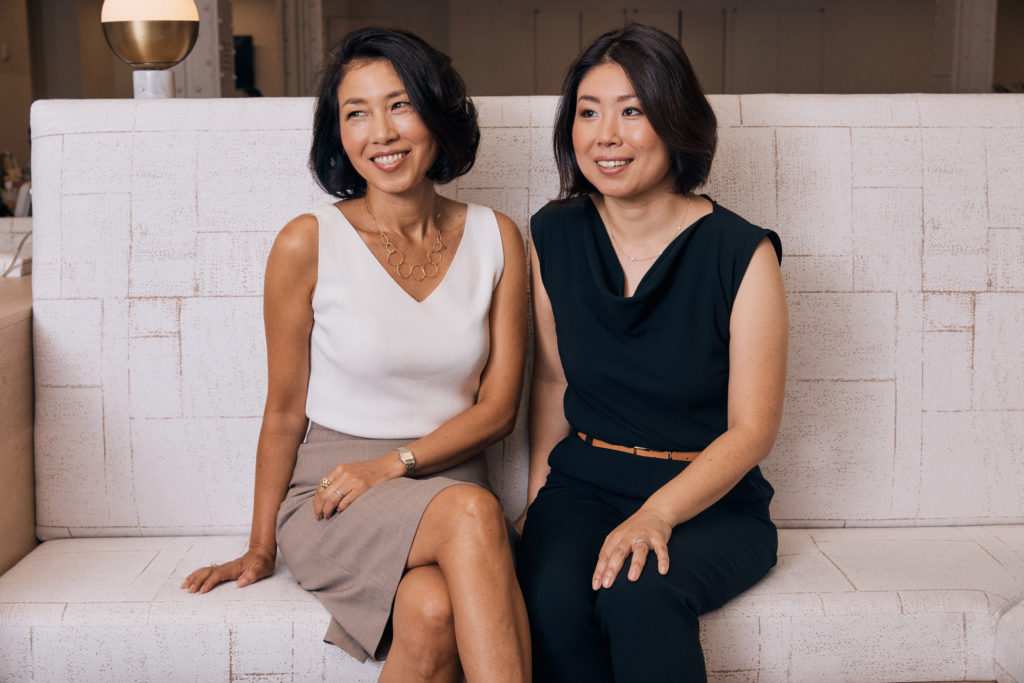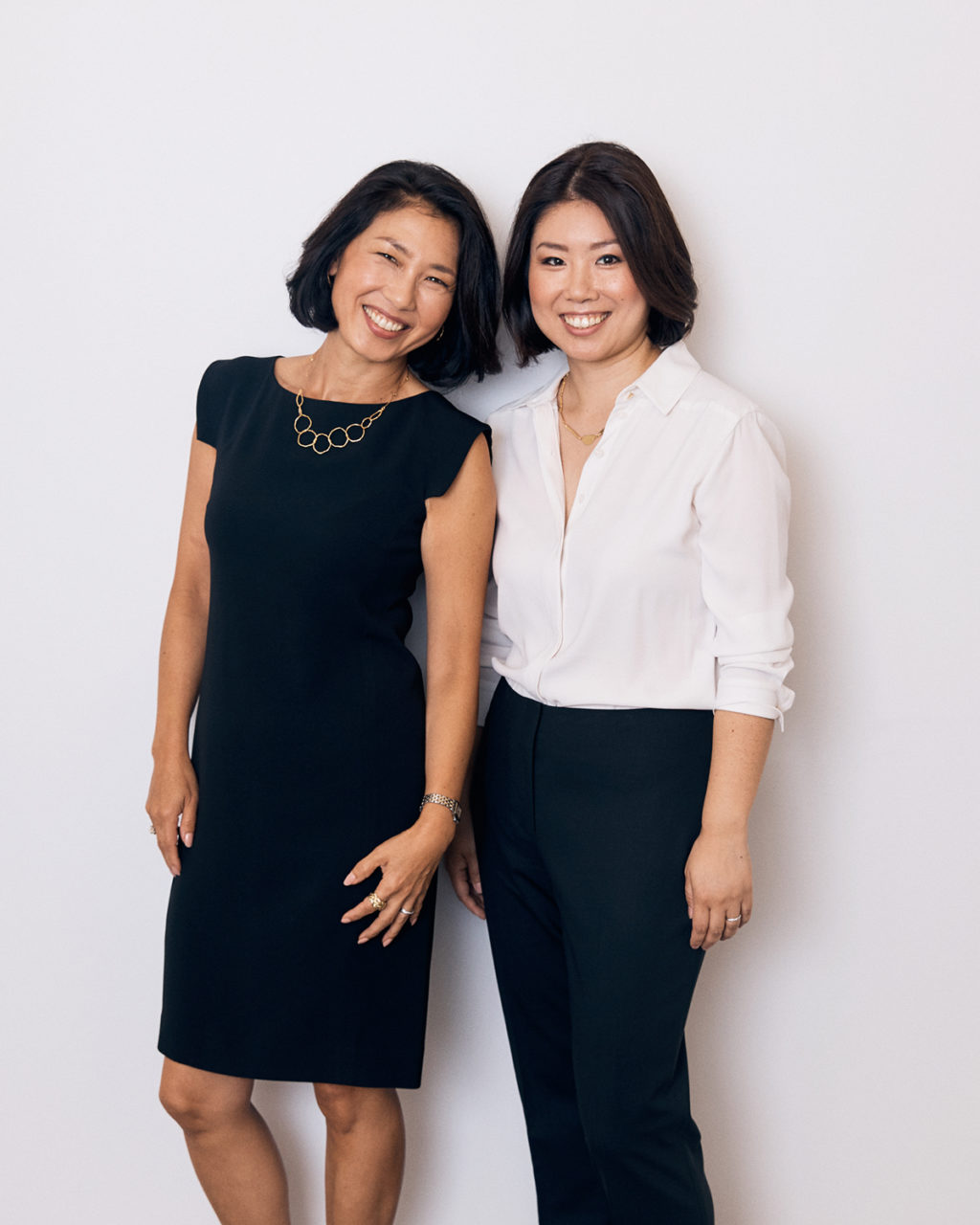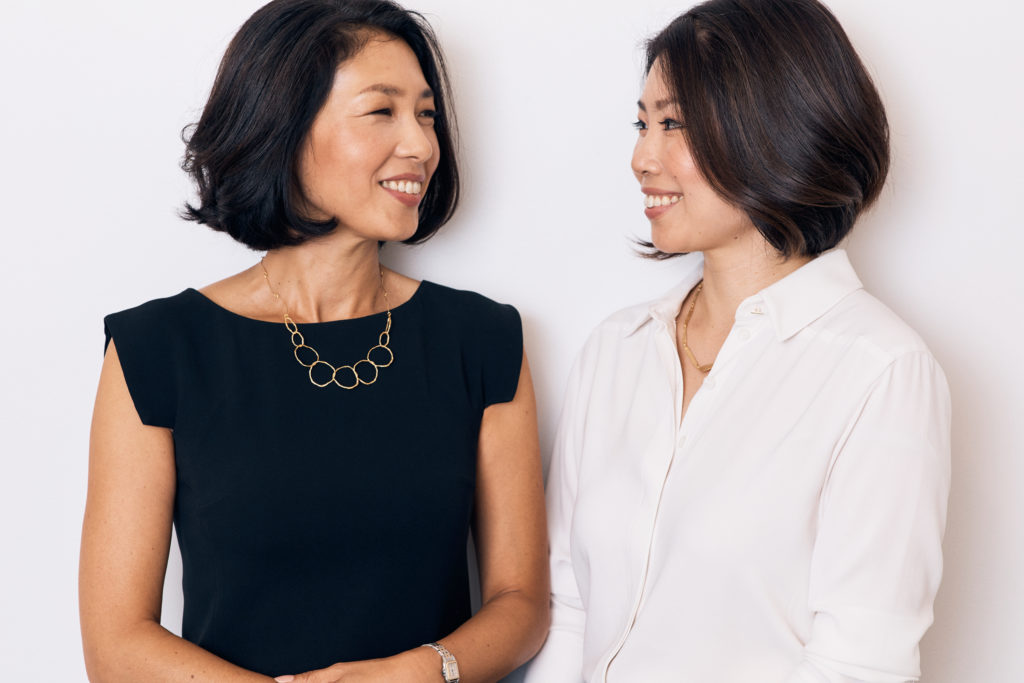‘Who Do You Want to Be at 50?’ And Other Helpful Career Questions
August 24, 2018 | Filed in: Woman of the Week
Business partners Mishuku (Mish) Matsuda and Chizuru (Chi) Otsuka grew up in the U.S. and Japan, respectively, and met somewhere in the middle: After they both worked in New York and Tokyo for Goldman Sachs, they became the co-founders of ASG Works, a consulting and executive coaching firm for professional women. Meanwhile, they also started The Choice, an invitation-only business network that provides resources for Asian women around the world (it is named after the J.K. Rowling quote, “It is our choices that show what we truly are, far more than our abilities”). Here, Mish and Chi discuss the power of dressing for the job you want, how to project confidence across different cultural settings, and the challenges that many Asian women encounter in the workplace.

Chi (left) wears the Peggy top in ivory, the Cobble Hill skirt in cashew, and the Helene necklace. Mish (right) wears the Rowling top and the Clooney pant in black, the Accent belt in sand dune, and the Five Stone necklace.
Chi, you grew up in Tokyo. What brought you to the U.S.?
Chi: When I was growing up in Japan, my mother owned a business, and she has always been my role model—she still is. She showed me that women could be powerful and elegant at the same time, so it was embedded in my brain from a young age that being a girl should not limit me in any way. But the culture in Tokyo is very dominated by men. My dad, a very typical Japanese man, used to say to me, ‘I wish you were a boy,’ because I always wanted to do more and be independent, which my mom encouraged but my school did not. For example, I wanted to be the president of my school, but I wasn’t allowed because only boys could do that. When I told my mother that I wanted to go to the U.S. for college, she said, ‘I think that’s a good idea.’ I wasn’t sure what I wanted to do with my career, but I was always very curious and wanted to be a leader.
I went to college in North Carolina and came back to Tokyo after I graduated. I got a dream job, by many people’s standards, but I hated it because I didn’t fit in with the culture. In Japan, there is a lot of social pressure for women to get married by 25. There’s this joke that girls are like Christmas cake: not edible after the 25th. And I didn’t even know if I wanted to get married at all! I really struggled. I was tired of feeling different all the time. Then I found this quote, from Coco Chanel: ‘Nature gives you the face you have at 20. Life shapes the face you have at 30. But at 50, you get the face you deserve.’ My mother was in her fifties at that point, and I asked her, ‘Do you like the face you have?’ And she said, ‘I love it.’ That’s when I decided I was going to focus on being somebody by 50, and forget about getting married. I changed jobs a few more times, continued to struggle, and then started working in finance. Eventually, I got hired at Goldman Sachs and moved to New York, and along the way I met my husband.
I worked at Goldman for 18 years total, ten years in New York and eight in Tokyo. I started out in one of their finance divisions, and then they asked if I wanted to go into human resources. My boss at the time said, ‘When somebody wants you, you should always consider it.’ So I took the job and loved it, and then I went back to Tokyo to lead the Asia team for seven years. When I was 47, I resigned, because 50 was around the corner—going back to that Chanel quote, I was thinking about where I wanted to be at 50, and I wanted to be back in the United States. Goldman hired me to be a diversity consultant for them, and I also worked as an executive coach—I had never thought to do that before, but because of my HR job, I was well-trained for it. And it was at that point that I met Mish.

Chi (left) wears the Sarah dress in black and the Helene necklace. Mish (right) wears the Virginia top in white, the Clooney pant in black, and the Aradia necklace.
Mish, what led you to Chi?
Mish: I didn’t have a clear idea of what I wanted to do after I graduated from college, but I was an economics major, so most of my job options were in consulting and finance. I had a more direct path to Goldman Sachs, but in my case I worked in the operations division. In terms of the skill set required and the people I worked with, it was a good fit, and I was there for over 11 years. I started in New York, and eight or nine years in, my husband got a job opportunity in Tokyo, and Goldman was able to transfer me to their office there. While I was in Japan, I started to spend a lot of time on people development and mentoring, which I really enjoyed. When it was time to come back to New York, I decided to leave Goldman and re-evaluate what I wanted to do. We had a one-year-old child, and I was looking for a job that felt more fulfilling and meaningful. After some soul searching, I decided to pursue career and executive coaching.
How did you two meet, and how did the initial connection blossom into a business partnership?
Chi: When I started doing executive coaching in New York, I wasn’t sure how much to charge. I was talking to my husband about it, and he had worked with Mish in Japan and suggested we meet.
Mish: At the time, I was doing career and executive coaching, predominantly with Asian women, and neither Chi nor I were looking for a business partner. We just saw each other as colleagues in the same field. But there was something that clicked right away, where we immediately understood that we shared a lot of the same values, and had very similar visions. And then one day she said, “What do you think about working together?” I think we both recognized that we could probably accomplish a lot more together than on our own. We are interested in a lot of the same things, but we have very different strengths and skills. Pooling our efforts has allowed us to divide and conquer; she’ll take the lead very naturally on certain things, and vice versa.

Chi (left) wears the Rachel dress in oak, the Sant Ambroeus jardigan in black, and the Helene necklace. Mish (right) wears the Deneuve top in cream, the Mejia pant in gray melange, and the Aradia necklace.
What made you both decide to work with Asian women, specifically?
Mish: I felt like there was a lack of support, in my previous corporate experience, for Asian women. They were underrepresented at the leadership level, given how many joined at the entry level. I also found that many of the values that are taught earlier in our lives, like humility, were at odds with what is expected in Western corporate culture. In many Asian cultures, it’s important to ensure that you’re not overly aggressive or arrogant, whereas being assertive is desirable in a leader in Western culture. Those types of cultural differences make their way into how people communicate and present themselves. When I was in Tokyo, I noticed that a lot of the women on my team excelled at the work itself, but they struggled to present what they did or demonstrate to other people what their capabilities were. For example, instead of saying “I did this,” they would say, “We did this.” They often didn’t make direct eye contact. Even changing little things could help them come across as more confident, like making sure they took a meeting with a senior manager instead of shying away from that opportunity. There’s this strong sense of being a part of a group, or part of a team, and you are taught to not break away from that. Demonstrating your own unique value is very contrary to that culture.
Chi: Also, it’s not just that Asian women act differently—it’s men, too. The gender differences are much stronger than in the United States. It’s extreme. Now, a lot of people in Japan don’t even think I was born there because of the way I carry myself. A big part of it came from living in New York for 10 years, which changed the way I walk and speak and carry myself. This is something that bonded Mish and me. She came from the U.S., and I came from Japan, but we had a lot in common in Tokyo.
How does clothing play a role in the way you present yourself, professionally?
Chi: In Japan, people tend to dress more formally, and when I came to New York, I noticed that dressing very professionally gave me an advantage. Because I looked polished, people would think I was responsible and put me in charge of certain things. Once I started training other professionals, both in Asia and New York, my nickname became “Fashion Police.” I believe that clothing has power, but the goal is not for people to remember exactly what you’re wearing; the goal is for you to be heard, and sometimes your look can bring more power to what you are saying.
Mish: The way Chi dresses is very deliberate. She exudes presence and confidence. Having come from New York, I noticed that women in Japan are very well put together, but they’re often fixated on appearing more feminine and cute. Unfortunately, that takes away from their gravitas. That’s one of the things that we’re working to teach professional women: Clothing is a tool you can use. Obviously, appearance isn’t everything, but it certainly is part of how people interact with you and perceive you, and it may even alter the opportunities they give you.

Chi (left) wears the Sarah dress in black and the Helene necklace. Mish (right) wears the Virginia top and the Aradia necklace.
Can you tell us more about each of your professional wardrobes?
Chi: Every Friday, I look at the following week and think about where I am going and who I am meeting with. If I’m meeting with someone who is less formal, I may tone down my outfit or even coordinate it with them; if that person often wears a navy suit, I may wear navy as well. My basics are silk blouses and solid colors. The brain has to work harder to process patterns, and my goal is to not have anyone get distracted by what I am wearing.
Mish: When I worked in finance, I often found that putting on a jacket made me seem more authoritative. So if I was going to a meeting with someone above me, I might throw on a jacket, whereas if I was meeting with a team member about her career path and wanted to be more approachable, maybe I’d wear a sweater. But I almost always prefer slacks over skirts.
How do you walk the line between teaching women to act like the dominant culture—in some contexts, that would be Western men—and also promoting diversity, which is inherently about celebrating our differences as strengths?
Chi: We are more interested in looking to the future than telling people that what they’re doing now is wrong. We say, ‘It’s not about who you are right now. It’s about who you want to become.’ We are all evolving every day. Even if you look back five years, your standards were different then. So we ask people to project three years out: Who do you want to be then? We don’t push people towards any one direction; we ask them to develop the creative vision themselves.
Mish: It’s never about denying who you are. It’s about asking yourself, ‘What do I want to perfect and leverage?’ Obviously, every culture and every individual has different strengths; you want to recognize what they are, make sure you’re putting them forward, and present them in the most effective way.
Photographs by Jeff Allen.





